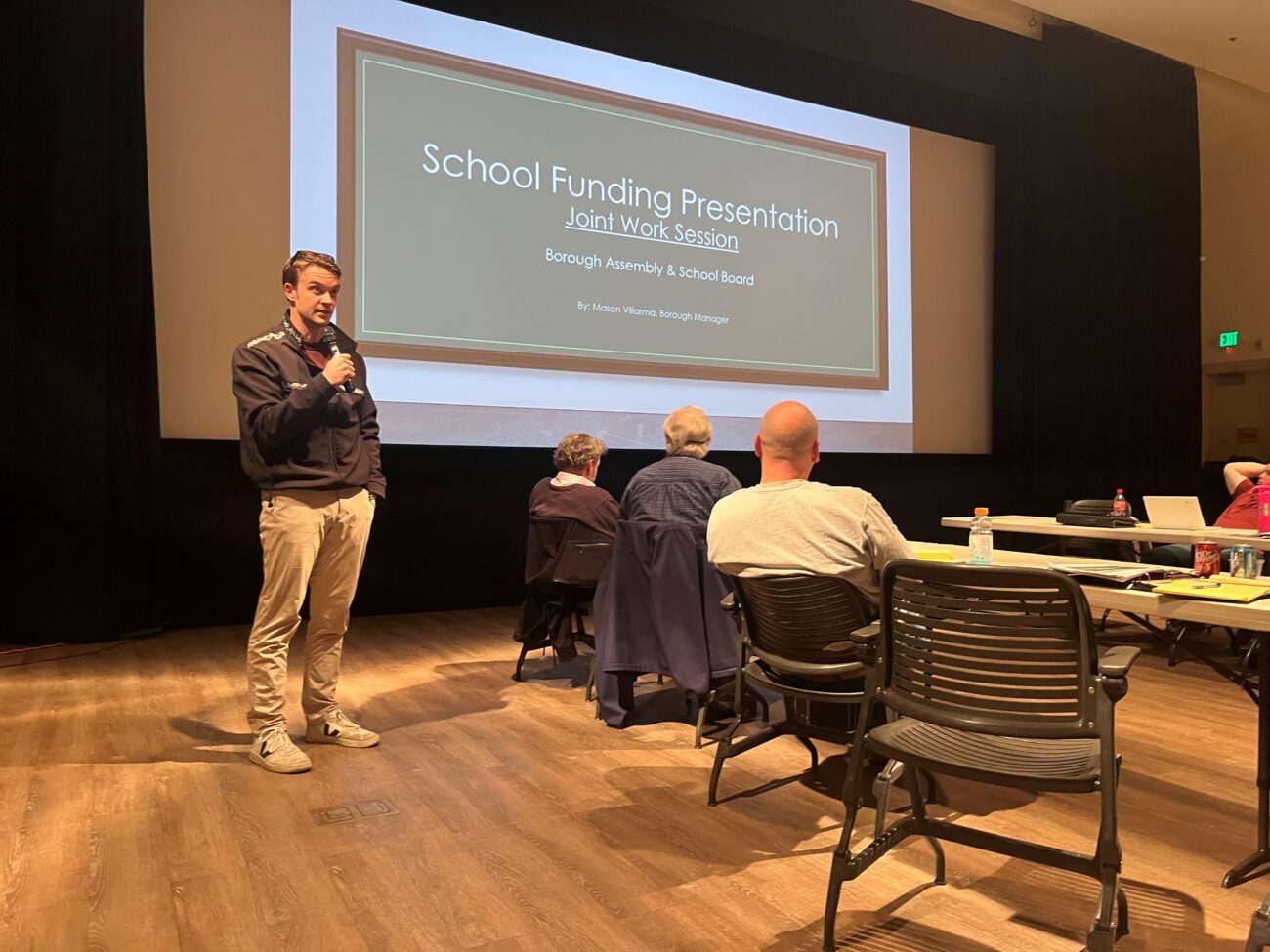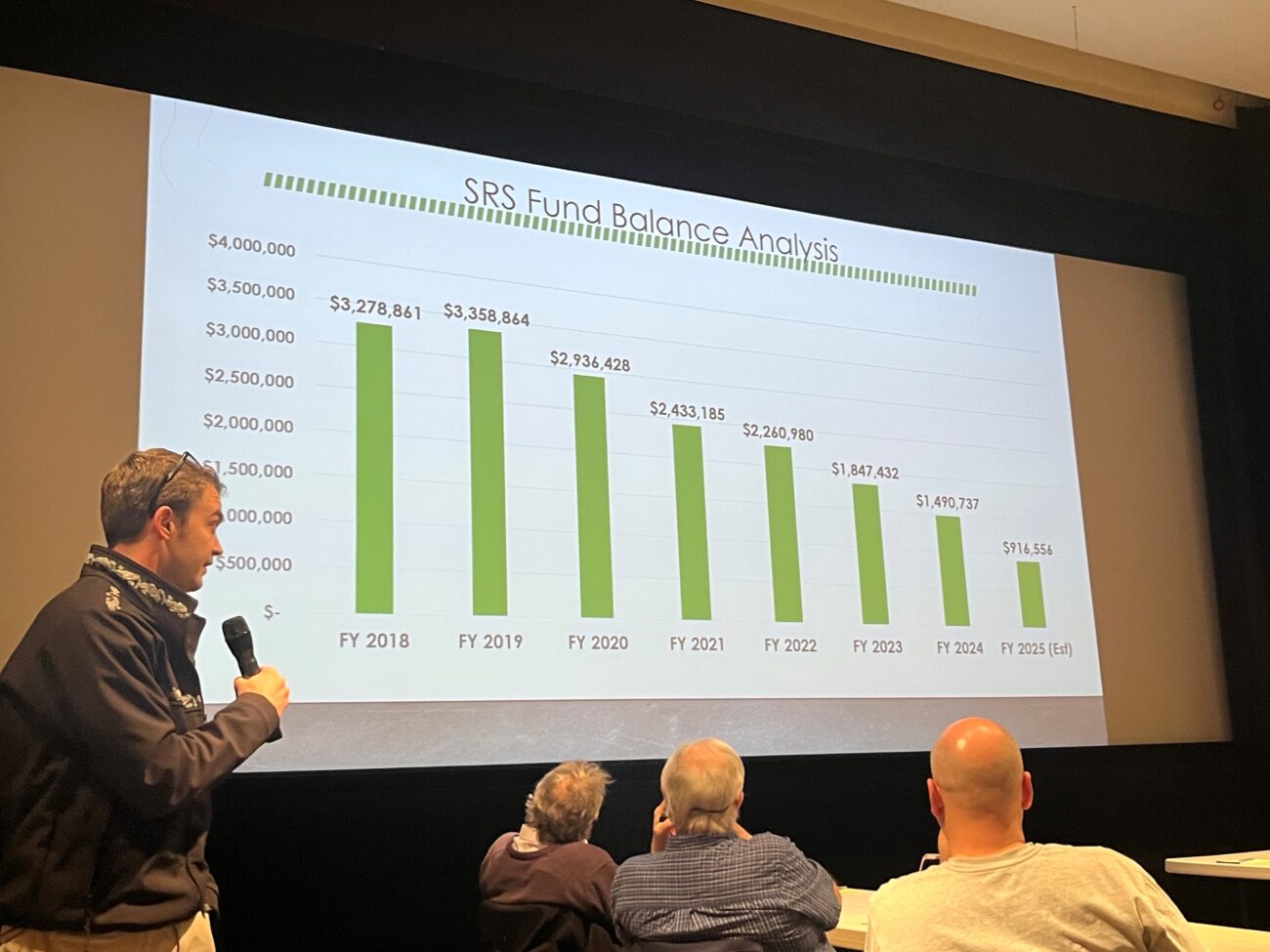
Wrangell’s preliminary school budget is setting the alarm for next year, which was presented to the borough last week at the Nolan Center. Many community members attended and voiced their opinions, which rarely happens at these meetings. Needless to say, both the school district and borough will be facing deficits for fiscal year 26.
Chief Financial Officer Kristy Andrew said the basic per-student funding or BSA has dropped over the years. Next year, the school district expects fewer students to be enrolled and $50 less per student than last year.
The budget isn’t relying on an increase in state funding, although lawmakers are considering it.
Right now, House Bill 69 could increase the BSA by $1,000.
“The $1,000 BSA increase would have a significant positive impact on the general fund budget, though further expenditure reductions would still be necessary and are still being made throughout the budget process, even though we have already made some cuts to the budget,” Andrew said.
The district is asking the borough for a maximum local contribution of $1.7 million to help fill in the funding gaps, even though the borough has been saying it can’t contribute the max.
“It is the additional allowable local contribution that really makes a difference in our budget,” Andrew said. “Everything above the minimum is what we can use towards maintaining staffing programs and services.”
The city funds not just the schools, but also infrastructure, roads and sidewalks through Secure Rural Schools funds. This is federal funding through National Forest receipts. But there’s a problem with SRS funding right now. Congress failed to pass a spending bill that would reauthorize it on the March 14 deadline.
No matter what, the school district faces a deficit
Andrew said that even if the city contributes the maximum amount allowed, the school district will still face a deficit.
She said, “The district is not asking the borough to fund education alone, but to help bridge the gap while we continue to pursue long term solutions.”
She said there are grant funds the district has that can only be used for very specific purposes, like the student activities fund and the scholarship fund. Then there’s the Capitol Improvement Fund with roughly $1.2 million.
“Funds are currently reserved for emergency maintenance projects, construction grant matches, upcoming school construction change orders; there is no mechanism or funding to replace the balance of this fund once it’s depleted,” Andrew said.
One reason why the district is losing money is that a handful of intensive special education students are relocating outside of Wrangell next year. Andrew said that’s a loss of $300,000 in revenue or approximately 6% of the total revenue budget.
“…what has the least impact on our education for our students.”
Andrew said she has gone line by line to try to find budget efficiencies and try to make cuts that wouldn’t significantly impact programs.
But she said they already made a lot of cuts, like reducing money for technology.
She said the district is considering other options for cost saving plans, like school consolidation, a four day school week and cutting staff.
“I think the board and administration are really weighing what has the least impact on our education for our students,” Andrew said. “And so those discussions are still ongoing.”
Mikki Angerman has been teaching at Wrangell Public Schools for the past 14 years and she’s also the president of the Wrangell Teachers Association.
Community members say the board should have more details and data
She and others said that the board should have more details on how much these potential cuts will save the district.
“I come to these meetings every single year, so I’ve been discussing this budget crisis that’s coming, that’s coming, that’s coming,” Angerman said. “Now it’s in front of us and knowing that this has been coming, why doesn’t the school board have any hard numbers to compare things such as the merger, the four day school week?”
School Board President Dave Wilson said he’s not sure how to answer Angerman’s question, but that the board has been exploring different options.
“Should we have maybe some more numbers? That’s a possibility and that’s something that we are working on right now to come up with more concrete numbers,” he said. “But we have been trying to sustain a quality education in Wrangell without continually losing programs, without cutting teachers, without cutting staff.”
Aaron Angerman said he knows what it takes to serve on the school board because he was on it for several years back in 2019.
“In all due respect, Mr. President, I think you’re missing the point,” he said. “You’re listing all the things we’re all wanting to save. I’ve been on this board (before) when we trimmed this thing, this budget. There’s no fat left on it. And every year we lose two teachers.”
He questioned when the board will start being proactive instead of reactive. He suggested the community forms a committee that will start looking at numbers and brainstorm how different options will look to save Wrangell’s education. One option he favors is consolidating schools, which would probably take several years. He said there’s many empty classrooms in the schools and consolidation would make sense.
“This is the toughest budget that I’ve had to create.”
Borough Manager Mason Villarma said the borough has the same problem as the school district in terms of the budget and changes need to happen. The borough itself is in a $640,000 deficit.
“This is the toughest budget that I’ve had to create,” he said. “This is my fourth budget, by far, the worst budget I’ll have to create. We’ve already slashed the general fund by 700,000. To put it into perspective, our general fund, and for the city, is about the exact same size as the district’s general fund.”
Villarma said when he became the finance director in 2021, they began funding the school district with 20% of sales taxes the borough charges. He anticipates about $740,000 from sales tax will go to the district next fiscal year. The borough combines the local contribution to the schools with the sales tax and SRS funds.
“We don’t have a proposed local contribution yet, although we have said since the fall time that it’s going to probably be in the range of 1.4 million, just because we know that’s a sustainable rate for the borough to fund the district,” he said.
But he said since legislators didn’t reauthorize SRS funds, the borough will also be in trouble.

“Secure rural schools has been a linchpin for the city to fund the school district, and without that, we’re automatically starting with an $802 million deficit in our ability to actually fund the schools and our own general fund,” Villarma said. “You can see the historical National Forest receipts or secure rural schools payments by fiscal year.”
Villarma said it’s possible that Congress could retroactively fund it for fiscal year 25. He said it’s unlikely though, based off conversations he’s had with the federal delegation.
Borough and school district plans a team effort on capital projects for school buildings
Both Villarma and the school board agreed to address capital projects as a team. If anything costs over $25,000 the borough will take care of it. Anything under $25,000 goes to the school district.
Villarma said no matter what, the school district will be in a deficit and either a lot of cuts will have to be made, or they can use CIP funds as a plug.
“The board thinks that buys you guys some time, and it buys us some time to see what the state does too,” he said. “It buys us some time to see what Secure Rural Schools does. But for the borough to spend down its reserves before the school district spends down its reserves would be imprudent, just due to the critical nature of the services that we are providing.”
The next draft budget will be presented to the board at the upcoming regular board meeting on April 14.
It’s unclear whether a public hearing will be ahead of that, but community members can voice their thoughts during the ‘Persons to be Heard’ portion.












